
- •About the Author
- •About the Technical Editor
- •Credits
- •Is This Book for You?
- •Software Versions
- •Conventions This Book Uses
- •What the Icons Mean
- •How This Book Is Organized
- •How to Use This Book
- •What’s on the Companion CD
- •What Is Excel Good For?
- •What’s New in Excel 2010?
- •Moving around a Worksheet
- •Introducing the Ribbon
- •Using Shortcut Menus
- •Customizing Your Quick Access Toolbar
- •Working with Dialog Boxes
- •Using the Task Pane
- •Creating Your First Excel Worksheet
- •Entering Text and Values into Your Worksheets
- •Entering Dates and Times into Your Worksheets
- •Modifying Cell Contents
- •Applying Number Formatting
- •Controlling the Worksheet View
- •Working with Rows and Columns
- •Understanding Cells and Ranges
- •Copying or Moving Ranges
- •Using Names to Work with Ranges
- •Adding Comments to Cells
- •What Is a Table?
- •Creating a Table
- •Changing the Look of a Table
- •Working with Tables
- •Getting to Know the Formatting Tools
- •Changing Text Alignment
- •Using Colors and Shading
- •Adding Borders and Lines
- •Adding a Background Image to a Worksheet
- •Using Named Styles for Easier Formatting
- •Understanding Document Themes
- •Creating a New Workbook
- •Opening an Existing Workbook
- •Saving a Workbook
- •Using AutoRecover
- •Specifying a Password
- •Organizing Your Files
- •Other Workbook Info Options
- •Closing Workbooks
- •Safeguarding Your Work
- •Excel File Compatibility
- •Exploring Excel Templates
- •Understanding Custom Excel Templates
- •Printing with One Click
- •Changing Your Page View
- •Adjusting Common Page Setup Settings
- •Adding a Header or Footer to Your Reports
- •Copying Page Setup Settings across Sheets
- •Preventing Certain Cells from Being Printed
- •Preventing Objects from Being Printed
- •Creating Custom Views of Your Worksheet
- •Understanding Formula Basics
- •Entering Formulas into Your Worksheets
- •Editing Formulas
- •Using Cell References in Formulas
- •Using Formulas in Tables
- •Correcting Common Formula Errors
- •Using Advanced Naming Techniques
- •Tips for Working with Formulas
- •A Few Words about Text
- •Text Functions
- •Advanced Text Formulas
- •Date-Related Worksheet Functions
- •Time-Related Functions
- •Basic Counting Formulas
- •Advanced Counting Formulas
- •Summing Formulas
- •Conditional Sums Using a Single Criterion
- •Conditional Sums Using Multiple Criteria
- •Introducing Lookup Formulas
- •Functions Relevant to Lookups
- •Basic Lookup Formulas
- •Specialized Lookup Formulas
- •The Time Value of Money
- •Loan Calculations
- •Investment Calculations
- •Depreciation Calculations
- •Understanding Array Formulas
- •Understanding the Dimensions of an Array
- •Naming Array Constants
- •Working with Array Formulas
- •Using Multicell Array Formulas
- •Using Single-Cell Array Formulas
- •Working with Multicell Array Formulas
- •What Is a Chart?
- •Understanding How Excel Handles Charts
- •Creating a Chart
- •Working with Charts
- •Understanding Chart Types
- •Learning More
- •Selecting Chart Elements
- •User Interface Choices for Modifying Chart Elements
- •Modifying the Chart Area
- •Modifying the Plot Area
- •Working with Chart Titles
- •Working with a Legend
- •Working with Gridlines
- •Modifying the Axes
- •Working with Data Series
- •Creating Chart Templates
- •Learning Some Chart-Making Tricks
- •About Conditional Formatting
- •Specifying Conditional Formatting
- •Conditional Formats That Use Graphics
- •Creating Formula-Based Rules
- •Working with Conditional Formats
- •Sparkline Types
- •Creating Sparklines
- •Customizing Sparklines
- •Specifying a Date Axis
- •Auto-Updating Sparklines
- •Displaying a Sparkline for a Dynamic Range
- •Using Shapes
- •Using SmartArt
- •Using WordArt
- •Working with Other Graphic Types
- •Using the Equation Editor
- •Customizing the Ribbon
- •About Number Formatting
- •Creating a Custom Number Format
- •Custom Number Format Examples
- •About Data Validation
- •Specifying Validation Criteria
- •Types of Validation Criteria You Can Apply
- •Creating a Drop-Down List
- •Using Formulas for Data Validation Rules
- •Understanding Cell References
- •Data Validation Formula Examples
- •Introducing Worksheet Outlines
- •Creating an Outline
- •Working with Outlines
- •Linking Workbooks
- •Creating External Reference Formulas
- •Working with External Reference Formulas
- •Consolidating Worksheets
- •Understanding the Different Web Formats
- •Opening an HTML File
- •Working with Hyperlinks
- •Using Web Queries
- •Other Internet-Related Features
- •Copying and Pasting
- •Copying from Excel to Word
- •Embedding Objects in a Worksheet
- •Using Excel on a Network
- •Understanding File Reservations
- •Sharing Workbooks
- •Tracking Workbook Changes
- •Types of Protection
- •Protecting a Worksheet
- •Protecting a Workbook
- •VB Project Protection
- •Related Topics
- •Using Excel Auditing Tools
- •Searching and Replacing
- •Spell Checking Your Worksheets
- •Using AutoCorrect
- •Understanding External Database Files
- •Importing Access Tables
- •Retrieving Data with Query: An Example
- •Working with Data Returned by Query
- •Using Query without the Wizard
- •Learning More about Query
- •About Pivot Tables
- •Creating a Pivot Table
- •More Pivot Table Examples
- •Learning More
- •Working with Non-Numeric Data
- •Grouping Pivot Table Items
- •Creating a Frequency Distribution
- •Filtering Pivot Tables with Slicers
- •Referencing Cells within a Pivot Table
- •Creating Pivot Charts
- •Another Pivot Table Example
- •Producing a Report with a Pivot Table
- •A What-If Example
- •Types of What-If Analyses
- •Manual What-If Analysis
- •Creating Data Tables
- •Using Scenario Manager
- •What-If Analysis, in Reverse
- •Single-Cell Goal Seeking
- •Introducing Solver
- •Solver Examples
- •Installing the Analysis ToolPak Add-in
- •Using the Analysis Tools
- •Introducing the Analysis ToolPak Tools
- •Introducing VBA Macros
- •Displaying the Developer Tab
- •About Macro Security
- •Saving Workbooks That Contain Macros
- •Two Types of VBA Macros
- •Creating VBA Macros
- •Learning More
- •Overview of VBA Functions
- •An Introductory Example
- •About Function Procedures
- •Executing Function Procedures
- •Function Procedure Arguments
- •Debugging Custom Functions
- •Inserting Custom Functions
- •Learning More
- •Why Create UserForms?
- •UserForm Alternatives
- •Creating UserForms: An Overview
- •A UserForm Example
- •Another UserForm Example
- •More on Creating UserForms
- •Learning More
- •Why Use Controls on a Worksheet?
- •Using Controls
- •Reviewing the Available ActiveX Controls
- •Understanding Events
- •Entering Event-Handler VBA Code
- •Using Workbook-Level Events
- •Working with Worksheet Events
- •Using Non-Object Events
- •Working with Ranges
- •Working with Workbooks
- •Working with Charts
- •VBA Speed Tips
- •What Is an Add-In?
- •Working with Add-Ins
- •Why Create Add-Ins?
- •Creating Add-Ins
- •An Add-In Example
- •System Requirements
- •Using the CD
- •What’s on the CD
- •Troubleshooting
- •The Excel Help System
- •Microsoft Technical Support
- •Internet Newsgroups
- •Internet Web sites
- •End-User License Agreement

Part V: Analyzing Data with Excel
Copying a Pivot Table
A pivot table is very flexible, but it does have some limitations. For example, you can’t add new rows or columns, change any of the calculated values, or enter formulas within the pivot table. If you want to manipulate a pivot table in ways not normally permitted, make a copy of it.
To copy a pivot table, select the entire table and choose Home Clipboard Copy (or, press Ctrl+C). Then select a new worksheet and choose Home Clipboard Paste Paste Values. The pivot table formatting is not copied — even if you repeat the operation and use the Formats option in the Paste Special dialog box.
To copy the pivot table and its formatting, use the Office Clipboard to paste. If the Office Clipboard is not displayed, click the dialog box launcher in the bottom right of the Home Clipboard group.
The contents of the pivot table are copied to the new location so that you can do whatever you like to them.
Note that the copied information is not a pivot table, and it is no longer linked to the source data. If the source data changes, your copied pivot table will not reflect these changes.
More Pivot Table Examples
To demonstrate the flexibility of this feature, I created some additional pivot tables. The examples use the bank account data and answer the questions posed earlier in this chapter (see “A pivot table example”).
Question 1
What is the daily total new deposit amount for each branch?
Figure 34.13 shows the pivot table that answers this question.
•The Branch field is in the Column Labels section.
•The Date field is in the Row Labels section.
•The Amount field is in the Values section and is summarized by Sum.
Note that the pivot table can also be sorted by any column. For example, you can sort the Grand Total column in descending order to find out which day of the month had the largest amount of new funds. To sort, just right-click any cell in the column to sort and choose Sort from the shortcut menu.
708
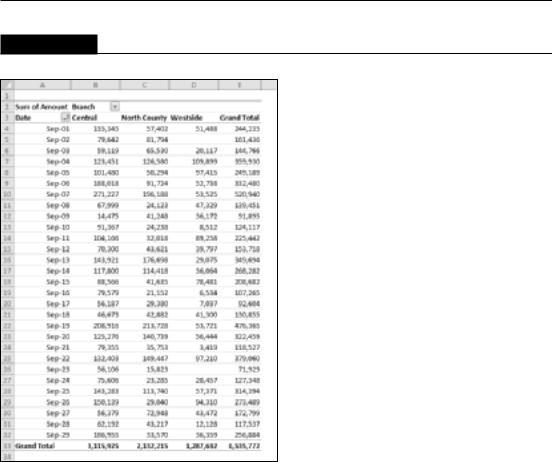
Chapter 34: Introducing Pivot Tables
FIGURE 34.13
This pivot table shows daily totals for each branch.
Question 2
Which day of the week accounts for the most deposits?
Figure 34.14 shows the pivot table that answers this question.
•The Weekday field is in the Row Labels section.
•The Amount field is in the Values section and is summarized by Sum.
I added conditional formatting data bars to make it easier to see how the days compare.
Cross-Reference
See Chapter 20 for more information about conditional formatting. n
709
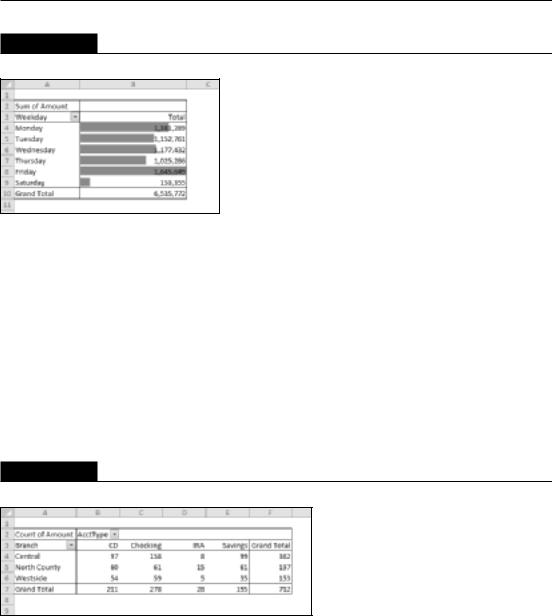
Part V: Analyzing Data with Excel
FIGURE 34.14
This pivot table shows totals by day of the week.
Question 3
How many accounts were opened at each branch, broken down by account type?
Figure 34.15 shows a pivot table that answers this question.
•The AcctType field is in the Column Labels section.
•The Branch field is in the Row Labels section.
•The Amount field is in the Values section and is summarized by Count.
The most common summary function used in pivot tables is Sum. In this case, I changed the summary function to Count. To change the summary function to Count, right-click any cell in the Value area and choose Summarize Data By Count from the shortcut menu.
FIGURE 34.15
This pivot table uses the Count function to summarize the data.
Question 4
What’s the dollar distribution of the different account types?
Figure 34.16 shows a pivot table that answers this question. For example, 253 of the new accounts were for an amount of $5,000 or less.
710
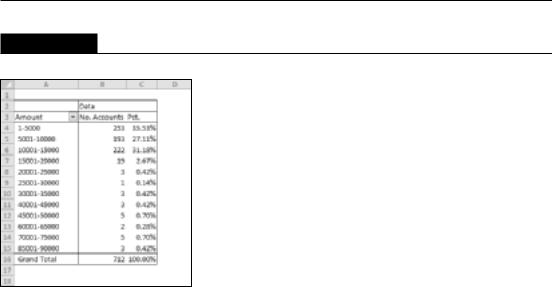
Chapter 34: Introducing Pivot Tables
FIGURE 34.16
This pivot table counts the number of accounts that fall into each value range.
This pivot table is unusual because it uses only one field: Amount.
•The Amount field is in the Row Labels section (grouped).
•The Amount field is also in the Values section and is summarized by Count.
•A third instance of the Amount field is the Values section, summarized by Percent of Total.
When I initially added the Amount field to the Row Labels section, the pivot table showed a row for each unique dollar amount. I right-clicked one of the Row Labels and chose Group from the shortcut menu. Then I used the Grouping dialog box to set up bins of $5,000 increments.
The second instance of the Amount field (in the Values section) is summarized by Count. I rightclicked a value and chose Summarize Data By Count from the shortcut menu.
I added another instance of Amount to the Values section, and I set it up to display the percentage. I right-clicked a value in column C and chose Show Values As % of Grand Total. This option is also available in the Show Values As tab of the Value Field Settings dialog box.
Question 5
What types of accounts do tellers open most often?
Figure 34.17 shows that the most common account opened by tellers is a Checking account.
•The AcctType field is in the Row Labels section.
•The OpenedBy field is in the Report Filters section.
711
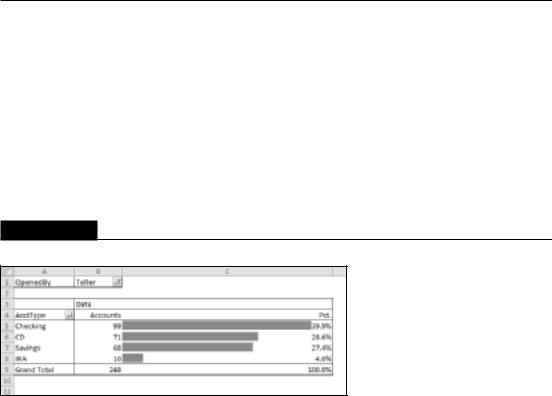
Part V: Analyzing Data with Excel
•The Amount field is in the Values section (summarized by Count).
•A second instance of the Amount field is in the Values section (summarized by % of Total).
This pivot table uses the OpenedBy field as a Report Filter and is showing the data only for Tellers. I sorted the data so that the largest value is at the top, and I also used conditional formatting to display data bars for the percentages.
Cross-Reference
See Chapter 20 for more information about conditional formatting. n
FIGURE 34.17
This pivot table uses a Report Filter to show only the Teller data.
Question 6
How does the Central branch compare with the other two branches?
Figure 34.18 shows a pivot table that sheds some light on this rather vague question. It simply shows how the Central branch compares with the other two branches combined.
•The AcctType field is in the Row Labels section.
•The Branch field is in the Column Labels section.
•The Amount field is in the Values section.
I grouped the North County and Westside branches together and named the group Other. The pivot table shows the amount, by account type. I also created a pivot chart for good measure. See Chapter 35 for more information about pivot charts.
712
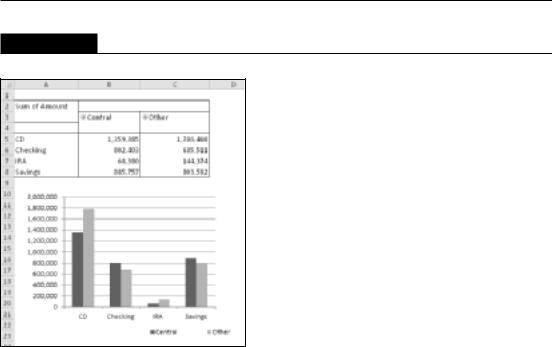
Chapter 34: Introducing Pivot Tables
FIGURE 34.18
This pivot table (and pivot chart) compares the Central branch with the other two branches combined.
Question 7
In which branch do tellers open the most checking accounts for new customers?
Figure 34.19 shows a pivot table that answers this question. At the Central branch, tellers opened 23 checking accounts for new customers.
•The Customer field is in the Report Filters section.
•The OpenedBy field is in the Report Filters section.
•The AcctType field is in the Report Filters section.
•The Branch field is in the Row Labels section.
•The Amount field is in the Values section, summarized by Count.
This pivot table uses three Report Filters. The Customer field is filtered to show only New, the OpenedBy field is filtered to show only Teller, and the AcctType field is filtered to show only Checking.
713
